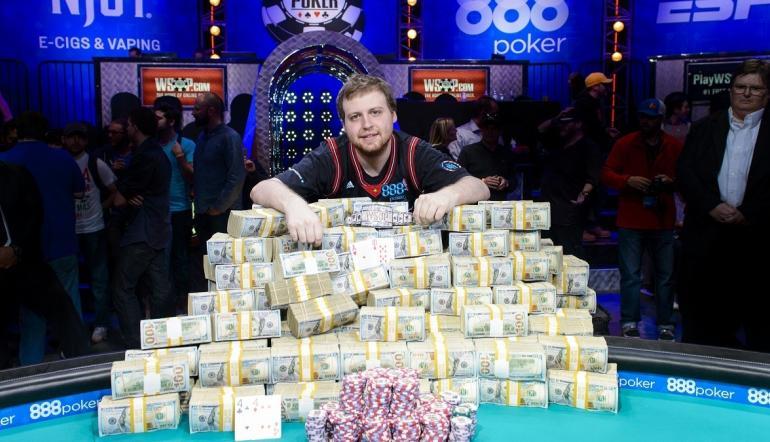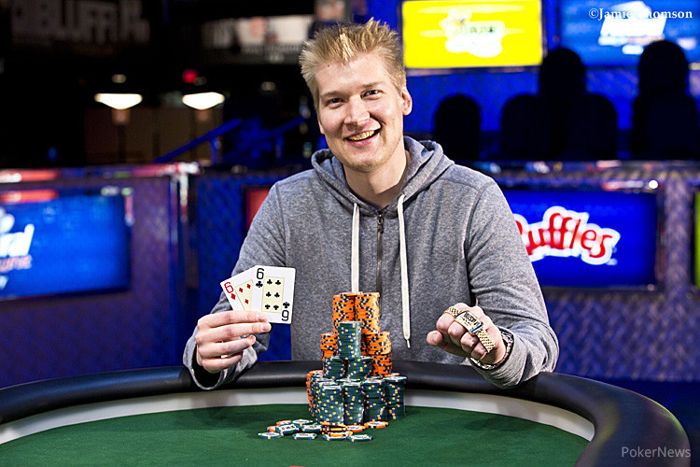World Series Of Poker Final Table Payout
A constant second derivative. The golden ratio. Newtonian optimization.
The 2015 WSOP Main Event will pay out at least 1,000 players, and every final table member will win at least $1 million. (Image: pokerstarsblog.com) The World Series of Poker has made a change to the payout structure of the 2015 Main Event, guaranteeing payouts to far more players but removing the $10 million guarantee that existed last year. With four World Series of Poker bracelets to his name, including one earlier this year, the understated Las Vegas resident remains well positioned going into the final table. The Orthodox Jewish resident of Bergenfield, New Jersey, is one of nine contestants to advance to the last round of the no-limit Texas Hold ‘em tournament, whose winner — considered to be the world. “Ladouceur and Strelitz were happily cruising to the Final Table and then they were gone.” ADVERTISEMENT: Bet the World Series of Poker Final Table odds at Bovada and earn a whopping bonus up to $1,000. Eight Americans sit around the table, but.
If one didn’t know where he was, he might assume he had stumbled into a Mensa meeting.
But those phrases are merely the excited words of a few diligent men explaining how they created what is probably the most equitable payout structure the World Series of Poker has ever seen.
“I think this is a poker player’s dream payout,” said Jack Effel, WSOP tournament director. “The payouts look really good this year.”
Poker is a lot of things. A gutsy call. An aggressive shove. A well-timed laydown. But it is also, of course, about money — how much the winner gets, how many people are paid out in a tournament, and all of the levels in between.
The details are hardly insignificant. Matt Savage, the respected tournament director who has overseen hundreds of poker tournaments, said that a payout structure could determine whether or not a player comes back to the game.
“If a player cashes and doubles his buy-in, he’ll probably play the next day’s event. But if he doesn’t cash, he might not play the next day,” said Savage. “And if all of the money is going to a small number of players, the money will dry up a lot sooner.”
Effel has been working on the creation of a better payout structure since he became assistant tournament director of the World Series in 2005. Four years later, after many long hours and the help of a few tireless allies, he thinks he’s got it right. That’s not to say he won’t ever tweak his structure, but he finally believes he’s got a sound system.
“I think I’ll use this model forever,” said Effel.
From Winner-Take-All to a Flattened Structure
In the early days, the World Series main event was advertised as a winner-take-all event to the public, while the players would privately divvy up the pool amongst the top finishers. Eventually, tournament organizers realized it was prudent to spread out the money a little bit so that players weren’t forced into making backroom deals.
Tournament organizers established a payout structure, although it hardly resembled what players are familiar with today.
“When I first started out, first place was 50 percent (of the prize pool), second place was 20 percent, and third place was 10 percent for the big events like the World Series,” said Jack McClelland, the Bellagio tournament director who has more than 25 years of experience overseeing tournaments, as well as a regular segment on Card Player TV. “It was just too much gambling for the percentages.”
It’s practically unfathomable to imagine the payouts if that structure was used in the modern era. Peter Eastgate, the reigning main-event champ, would’ve made more than $32 million if the 50-percent-to-the-winner structure was used, more than $64 million if last year’s main event was winner-take-all.
Of course, it is highly unlikely the main event would’ve attracted such a large tournament field as it did if it didn’t have a reasonable payout structure. Thousands of dreamers shelled out 10 grand with the knowledge that about 10 percent of the field will make at least some kind of profit. It’s doubtful that such a large number would pay that kind of money for a one-in-thousands shot at a massive payday.
Savage says that online poker deserves most of the credit for the flattened payouts.

“Online poker had a lot to do with it,” said Savage. “Online payouts are very, very flat — 15 percent to 12 percent for first place.”
The popular Sunday Million tournament on PokerStars pays approximately 15 percent of the prize pool to the winner, depending upon the number of entrants.
“Even though players tell you they want to play for a bigger first-place prize, when it comes down to the money bubble, you see how many players care about it,” said Savage. “A flattened payout is better for the players.”
However, even with the flattening of the payout over the years, there have been problems and oversights. When Effel was given the responsibility of creating a payout structure for his first main event in 2005, he realized he had a daunting task when a record number of people registered for the big show.
“Payouts had never been created for a field size that large,” Effel said, of the 5,619 players who played in the main event that year. Effel tried to put together a payout structure by hand, but he quickly realized it would be an extremely arduous task. He needed help, but fortunately for him, he knew exactly who to call.
Constrained Optimization
Dr. Adam Schwartz is a professor of business administration with expertise in numerical programming and financial modeling at Washington and Lee University in Virginia. He taught Effel when he was a student at Ole Miss.
When Effel was running into problems creating an effective payout structure for the 2005 World Series, he called on his former teacher to lend a hand.
“The way it had been done in the past, someone used a paper and pencil and said, ‘We’re going to pay like this,’” said Schwartz. “But when you’re paying out so many players, the problem almost becomes unmanageable.”
That’s where mathematical theory came in. What Isaac Newton helped establish in the late 1600s was helping poker organizers create their payout structure in the early 2000s.
“What I did was something called the constrained optimization program,” said Schwartz. “It’s a kind of problem in math where you have a limited number of resources and a bunch on constraints. In this case, the constraints would be things like how much the payout changes from one place to another.”

On the final starting day of the main event in 2005, Effel called Schwartz and told him the total number of players in the field. Less than 30 minutes later, after Schwartz programmed the numbers into his model and after Effel and tournament organizers made a couple changes, the payout structure was announced on the Rio floor.
“Were the payouts great? They were OK,” said Effel. “But they could’ve been a lot better.”
There were definitely some awkward payout jumps in 2005. From 46th place to 45th place, there was a jump of nearly $62,000, but later on up the ladder, from 37th place to 36th place, there was only an increase of about $39,000.
Those inconsistencies were even more visible in the top payouts. Tenth place received $600,000 in 2005, while ninth place got $1 million and eighth place was awarded $1.15 million. In other words, the jumps went from a $400,000 increase to just a $150,000 increase.
Effel knew he needed to have a smoother payout structure in the future.
The Art of the Payout Structure
In 2006, as time-consuming as it was, the tournament organizers completed all of the payout structures by hand in an effort to create a more effective system.

Unfortunately, they didn’t realize just how top-heavy they had made their structure until Jamie Gold had collected his $12 million payday.
“When 2006 ended, Barry Greenstein came to us and said, ‘Man, your payouts are really, super top-heavy,” said Effel. “He told us, ‘These are what they should’ve been.’”
Greenstein’s initiative helped the ball start rolling.

“It was a relatively clean set of payouts,” said Effel. “First place would’ve gotten $10 million as opposed to $12 million, and there was a smooth progression up to the final table.”
Of course, Greenstein had the luxury of creating his payout structure well after the number of players had been announced.
Still, Effel knew he had a solid model to work off of. And in 2007, he benefited from additional help. Howard Lederer offered his time to assist Effel in creating a better system.
“In 2007, Howard Lederer and I took this model of 8,773 players that Barry created and we put all those numbers into percentages, then we created payouts to the left and to the right of that number,” said Effel, estimating the two of them probably spent close to 200 hours creating the numbers. “And guess what, the payouts improved a little bit more.”
But they still weren’t perfect. Greenstein again approached Effel after the World Series and told him what was missing.
“Barry comes up to me and says, ‘Jack, we really need to tighten up the ratio between each place at the final table,” said Effel. “He said, ‘We really should use golden ratios for every place at the final table.’
“Golden ratios are a mathematical calculation that shows a relationship between a larger number and a smaller number,” said Effel. “It’s a concept that dates back to Ancient Greece.”
Difficult to fully explain, it was even more difficult to execute.
“Trying to do that by hand is virtually impossible,” said Effel.
“I could use the 2008 percentages and no one would probably ever know the difference except for a poker player who’s also a mathematician.” Still, it wasn’t good enough for Greenstein or Effel. Determined to get it right, Effel called on Schwartz again to help out for the 2009 World Series.
Using the constrained optimization model and ensuring that the golden ratio was used for the first few spots of the final table, Greenstein and Effel told Schwartz exactly what they wanted in their payout structure.
“Adam put it all to life,” said Effel.
“It’s part art and it’s part math,” said Schwartz. “Barry, Jack, and I exchanged about 60 e-mails. We went back and forth to try to come up with a way to make the payouts work. They described the art to me — how to pay a poker field — and I would try to write that into the math.”
Schwartz was determined to correct the earlier issues concerning the transitions in pay.
“My goal was to have smooth transitions and you can do that mathematically,” said Schwartz. “To do that, you need to have a constant second derivative.”
After hundreds upon hundreds of hours spread out over four years, Effel believes that the World Series finally has it right.
If this structure was used last year with the same number of entries, the top 12 finishers would’ve become millionaires instead of the top eight. Eastgate still would’ve had a handsome payday — not quite $9.1 million, but approximately $8.7 million.
World Series Poker Set
“Poker tournaments should have a big prize, and first place in 2009 will still have a heck of a payout,” said Effel.
Final Table Payout
With the new structure, it’s unlikely anyone will record a more impressive payday than Gold’s historic $12 million cash in the near future. With the new payouts, the main event could welcome nearly 10,000 players this year — dwarfing the record field of 8,773 players in 2006 — and the winner would still “only” receive about $10 million.
While a couple of players might receive a few less bucks with the new system, it seems evident that the majority of the hundreds of players who cash in the World Series this year will probably benefit from the new structure. And that, Effel says, is what it’s all about.